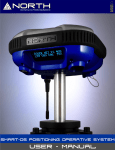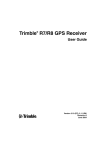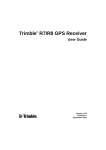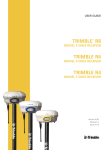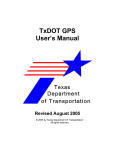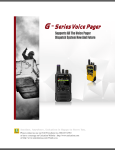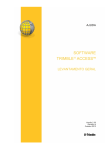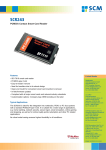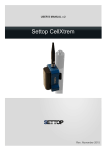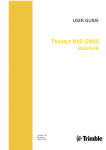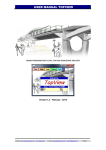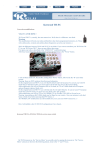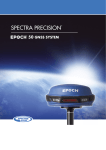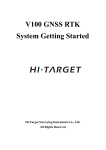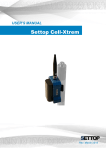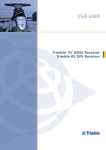Download User Manual North K-Series Receiver
Transcript
North Group LTD. User Manual – GNSS RTK Receiver SmaRTK Series 1 User Manual – GNSS RTK Receiver SmaRTK Series Copyright Copyright 2007-2013 North. © 2007 North Group LTD. All rights reserved. North is trademark of North Group LTD. All other trademarks are the property of their respective owners, 2007. Trademarks North Group LTD. All product and brand names mentioned in this publication are trademarks of their respective holders. 2 User Manual – GNSS RTK Receiver SmaRTK Series Safety Information This manual describes North Smartk. Before you use your receiver make sure that you have read and understood this publication, as well as safety requirements Warning and cautions An absence of specific alerts does not mean that there are no safety risks involved. Always follow the instructions that accompany a Warning or Caution. The information they provide is intended to minimize the risk of personal injury and/or damage to the equipment. In particular, observe safety instructions that are presented in the following formats: WARNING – A Warning alerts you to a likely risk of serious injury to your person and/or damage to the equipment. A warning identifies the nature of the risk and the extent of possible injury and/or damage. It also describes how to protect yourself and/or the equipment from this risk. Warnings that appear in the text are repeated at the of the manual. CAUTION – A Caution alerts you to a possible risk of damage to the equipment and/or loss of data. A Caution describes how to protect the equipment and/or data from this risk. Regulations and safety North Group LTD. The receivers contains integral Bluetooth® wireless technology, and may also send radio signals through the antenna of an internal radio-modem, or through an externally-connected data communications radio. Regulations regarding the use of radio-modems vary greatly from country to country. In some countries, the unit can be used without obtaining an end-user license. Other countries require end-user licensing. For licensing information, consult your local North dealer. Bluetooth operates in license-free bands Type approval Type approval, or acceptance, covers technical parameters of the equipment related to emissions that can cause interference. Type approval is granted to the manufacturer of the transmission equipment, independent from the operation or licensing of the units. Some countries have unique technical requirements for operation in particular radio-modem frequency bands. To comply with those requirements, North Group LTD may have modified your equipment to be granted Type approval. Unauthorized modification of the units voids the Type approval, the warranty, and the operational license of the equipment. Local regulations should be observed by the end user. 3 User Manual – GNSS RTK Receiver SmaRTK Series Operation near other radio equipment When operating the receiver in member states of the European Union and in other counties which adhere to the EU R&TTE requirements, while in the vicinity of aeronautical radio navigation equipment operating between 2700 and 2900 MHz, or Fixed, Fixed Satellite (space to Earth), or Mobile systems operating at 4170 MHz, a minimum separation of 5 meters must be maintained between the receiver and such radio equipment. Exposure to radio frequency radiation For 410MHz to 470 MHz radio WARNING: Exposure to RF energy is an important safety consideration. The FCC has adopted a safety standard for human exposure to radio frequency electromagnetic energy. Proper use of this radio modem results in exposure below government limits. The following precautions are recommended: • DO NOT operate the transmitter when someone is within 20 cm (7.8 inches) of the antenna. • DO NOT collocate (place within 20 cm) the radio antenna with any other transmitting antenna. • DO NOT operate the transmitter unless all RF connectors are secure and any open connectors are properly terminated. • DO NOT operate the equipment near electrical blasting caps or in an explosive atmosphere. • All equipment must be properly grounded according to North installation instructions for safe operation. • All equipment should be serviced only by a qualified technician. FOR GSM RADIO North Group LTD. – GSM / GPRS antenna is internal FOR BLUETOOTH RADIO The radiated output power of the internal Bluetooth wireless radio is far below the FCC radio frequency exposure limits. Nevertheless, the wireless radio shall be used in such a manner that the North receiver is 20 cm or further from the human body. The internal wireless radio operates within guidelines found in radio frequency safety standards and recommendations, which reflect the consensus of the scientific community. North therefore believes the internal wireless radio is safe for use by consumers. The level of energy emitted is far less than the electromagnetic energy 4 User Manual – GNSS RTK Receiver SmaRTK Series emitted by wireless devices such as mobile phones. However, the use of wireless radios may be restricted in some situations or environments, such as on aircraft. If you are unsure of restrictions, you are encouraged to ask for authorization before turning on the wireless radio. Installing antennas CAUTION – For your own safety, and in terms of the RF Exposure requirements of the FCC, always observe the precautions listed here. - Always maintain a minimum separation distance of 20 cm (7.8 inches) between yourself and the radiating antenna on the North K-Series Receiver or the radio-modem. - Do not collocate (place within 20 cm) the radio antenna with any other transmitting antenna This device has been designed to operate with the antennas listed below. UHF Antennas not included in this list, or that have a gain greater than 5 dBi, are strictly prohibited for use with this device. The required antenna impedance is 50 Ω. The antennas that can be used (country dependent) are 0 dBi and 5 dBi whip antennas. The antenna used with the GSM radio is 0 dBi internal antenna. To reduce potential radio interference to other users, the antenna type and its gain should be so chosen that the equivalent isotropically radiated power (e.i.r.p.) is not more than that permitted for successful communication. North Group LTD. Rechargeable Lithium-ion batteries These receivers use one rechargeable Lithium-ion batteries of 2600 mAh each (7.4 V - 5200 mAH): a technology which has an high energy-to-weight ratio with respect to NiCd or NiMh batteries, lack of memory effect, and slow self‐discharge when not in use WARNING – Charge and use the rechargeable Lithium-ion battery only in strict accordance with the instructions. Charging or using the battery in unauthorized equipment can cause an explosion or fire, and can result in personal injury and/or equipment damage. 5 User Manual – GNSS RTK Receiver SmaRTK Series To prevent injury or equipment damage: WARNING – Never change power supply polarity. In doing so, the receiver would be irreversibly damaged. A receiver damaged due to inverse polarity is not covered by warranty. – Charge the Lithium-ion battery only in a North product that is specified to charge it. The correct charger must be 12V with 2000 mAh, with a 5.5mm x 2.1mm power plug with negative pole outside and positive polarity on the inside. – Be sure to follow all instructions that are provided with the battery charger. – Discontinue immediately charging a receiver battery that gives off extreme heat a burning odor or you hear a snaping sound inside the unit. These signs would indicate that the receiver has suffered an incident. Check the polarity used, and report to the North representative. – The batteries are included internally and are intended to me serviced by the North representative only. There are no serviceable parts inside. – Use only the cable and chargers supplied by North. North Group LTD. Other Warnings WARNING – Operating or storing the receiver outside the specified temperature range can damage it. 6 User Manual – GNSS RTK Receiver SmaRTK Series Content 1. Introduction ...................................................................................................................... 8 1.1 Related information ................................................................................................... 8 1.2 Technical assistance ................................................................................................... 8 1.3 Your comments.......................................................................................................... 9 2. Overview .......................................................................................................................... 9 2.1 Features .................................................................................................................... 9 2.2 Use and care ............................................................................................................ 10 2.3 COCOM limits .......................................................................................................... 10 3. Specs ....................................................................................................................... 11 3.1 Battery................................................................................................................. 11 3.2.1 GSM antenna internal and UHF internal is optional ........................................... 11 3.2.2 Operation near other radio equipment ............................................................. 11 3.2.3 Environmental conditions ................................................................................. 11 3.2.4 Sources of electrical interference ...................................................................... 12 3.3 General guidelines ................................................................................................... 12 3.3.1 Pole-mounted setup ......................................................................................... 12 3.4 Other system components ....................................................................................... 12 4. 3.4.1 Radios .............................................................................................................. 13 3.4.2 Internal GSM setup ........................................................................................... 14 3.4.3 Internal radio setup .......................................................................................... 14 General operation ........................................................................................................... 15 4.1 U- Cast UHF Radiomodem Amplifier ......................................................................... 19 North Group LTD. 4.2 Logging Data ............................................................................................................ 20 4.2.1 Logging internally ............................................................................................. 20 4.2.2 Logging to a North controller ............................................................................ 20 4.3 Batteries and Power................................................................................................. 21 4.4 5. Charging the Lithium-ion battery .......................................................................... 22 Specifications .................................................................................................................. 23 5.1 Positioning Specifications ......................................................................................... 23 6. Main menu .............................................................................................................. 24 7 User Manual – GNSS RTK Receiver SmaRTK Series 1. Introduction Thank you very much for choosing North Smartk receiver. This User Manual is designed to help you rapidly familiarize yourself with your new equipment The North Smartk Receiver User Guide describes how to install set up and use a North Smartk Receiver. Even if you have used other Global Positioning System (GPS) products before, North Group LTD recommends that you spend some time reading this manual to learn about the special features of your receiver. North Group LTD. assumes that you are familiar with the Windows® operating system and know how to use a mouse, select options from menus and dialogs, make selections from lists, and refer to online help. 1.1 Related information An electronic copy of this manual is available in portable document format (PDF) on the receiver CD-ROM. Use Adobe Reader to view the contents of this file. Other sources of related information are: Release notes – the release notes describe new features of the product, information not included in the manual, and any changes to the manual. They are provided as a PDF on the CD. Use Adobe Reader to view the contents of the release notes. North training courses – consider a training course to help you use your GPS system to its fullest potential. For more information, visit the North website at www.northsurveying.com. North Group LTD. 1.2 Technical assistance If you have a problem and cannot find the information you need in the product documentation, contact your local Dealer. Alternatively, you may contact technical support using the North Group website www.northsurveying.com. When contacting North Group support, please have the following information available: • Serial number of the unit • Model number or product name • Software type and version number North Group responds to calls by email, telephone or fax within the time limits set forth in support agreements. 8 User Manual – GNSS RTK Receiver SmaRTK Series If your problem cannot be solved by North Group Support, you may need to return your equipment for servicing and will be given specific directions. North Group LTD is not responsible for any damages incurred during shipment if the approved shipping container is not used. Shipping the units improperly can possibly void the warranty. 1.3 Your comments Your feedback about the supporting documentation helps us to improve it with each revision. Email your comments to [email protected] 2. Overview - OLED Display - VRS Network connection with NTRIP Protocol - UHF Transceiver communication with Transparent Protocol - UHF Band and Channel selection. - GNSS Raw data recording and file management - 3D Accelerometer compensator calibration and real-time reading . 2.1 Features The receiver provides the following features: • Millimetric-accuracy, real-time positioning with RTK data, up to 20 Hz position updates • Submeter-accuracy, real-time positioning using pseudorange corrections • Adaptive dual-frequency RTK engine • Automatic OTF (on-the-fly) initialization while moving • Double Lithium-ion rechargeable internal battery pack. North Group LTD. • Cable-free Bluetooth communications with most controllers • Standard LEMO port for RS-232 comunication • Input / Outpud data: – NMEA output by Serial and Bluetooth – RTCM2 input and output by UHF or GSM/GPRS Modems 9 User Manual – GNSS RTK Receiver SmaRTK Series – RTCM3 input and output by UHF or GSM/GPRS Modems – CRM input and output by UHF or GSM/GPRS Modems – CRM+ input and output by UHF or GSM/GPRS Modems • One TNC radio antenna connector to amplify the UHF signal. • Internal SD expansion slot for Raw RTCM3 data storage for PPS • Internal 410-470 MHz UHF radio transceiver with 48 pre-selected channels and custom channels setup. • 100x16 pixels graphical OLED display, industrial duty with direct-sunlight viewing capability. 2.2 Use and care The receiver can withstand the rough treatment that typically occurs in the field. However, it is a high-precision electronic instrument and should be treated with reasonable care. WARNING – Operating or storing the receiver outside the specified temperature range can damage it. High-power signals from a nearby radio or radar transmitter can overwhelm the receiver circuits. This does not harm the instrument, but it can prevent the receiver electronics from functioning correctly. Avoid using the receiver within 400 meters of powerful radar, television, or other transmitters. Low-power transmitters such as those used in cellphones and two-way radios normally do not interfere with receiver operations. North Group LTD. For more information, contact your local North distributor 2.3 COCOM limits The U.S. Department of Commerce and the European Union requires that all exportable GPS products contain performance limitations so that they cannot be used in a manner that could threaten the security of the contries. The following limitations are implemented on the receiver. Immediate access to satellite measurements and navigation results is disabled when the receiver’s velocity is computed to be greater than 1000 knots, or its altitude is computed to be above 18,000 meters. The receiver continuously resets until the COCOM situation is cleared. 10 User Manual – GNSS RTK Receiver SmaRTK Series 3. Specs 3.1 Battery The batteries are included internally. These receivers use rechargeable Lithium-ion battery. Batteries used (7.4 V - 5200 mAH). 3.2 GPRS Slot Insert SIM card into the slot, then use GPRS net as data communication way between base and rover. The premise is that you have already gone to local Mobile service center asking for net traffic and make sure the area where you are doing surveying have strong GPRS signal. 3.2.1 GSM antenna internal and UHF internal is optional Use this TNC connection for an external antenna for the UHF or to connect to the U-CAST amplifier see more information page 19. The GSM antenna is internal. 3.2.2 Operation near other radio equipment When operating the receiver in member states of the European Union and in other counties which adhere to the EU R&TTE requirements, while in the vicinity of aeronautical radionavigation equipment operating between 2700 and 2900 MHz, or Fixed, Fixed Satellite (space to Earth) or Mobile systems operating at 470 KHz, a minimum separation of 5 meters must be maintained between the receiver and such radio equipment. 3.2.3 Environmental conditions North Group LTD. Although the receiver has a waterproof housing, take reasonable care to protect the unit. Avoid exposure to extreme environmental conditions, including: • Water • Heat greater than 70 °C (167 °F) • Cold less than –40 °C (–40 °F) • Corrosive fluids and gases 11 User Manual – GNSS RTK Receiver SmaRTK Series 3.2.4 Sources of electrical interference Avoid the following sources of electrical and magnetic noise: • Gasoline engines (spark plugs) • Televisions and PC monitors • Alternators and generators • Electric motors • Equipment with DC-to-AC converters • Fluorescent lights • Switching power supplies 3.3 General guidelines WARNING – These receivers use a rechargeable Lithium-ion battery. To avoid personal injury or equipment damage, make sure that you read and understand the Safety Information on page 5 at the front of this manual The following guidelines apply whenever you set up the receiver for operation: • When plugging in a LEMO cable, make sure that the red dots on the receiver port and the cable connector line up. Do not use force to plug wire, as this may damage the connector pins. • When disconnecting a LEMO cable, grasp the cable by the sliding collar or lanyard and then pull the cable connector straight out of the port. Do not twist the connector or pull on the cable itself. 3.3.1 Pole-mounted setup To mount the receiver on a range pole: North Group LTD. 1. Thread the receiver onto the range pole. 2. Attach the controller bracket to the pole. 3. Insert the controller into the bracket. 3.4 Other system components This section describes optional components that you can use with the receiver. 12 User Manual – GNSS RTK Receiver SmaRTK Series 3.4.1 Radios Radios are the most common data link for Real-Time Kinematic (RTK) surveying. The receiver is available with an optional internal radio in the 410-470 MHz UHF band, and with an internal GSM/GPRS mobile modem as standard. You can also connect an external UHF radio transmitter to the LEMO receiver port, or U-CAST UHF amplifier by using the TNC port. - Long Range UHF Base Setup For a standard UHF setup, the base should be set as “Base UHF EXT”, that automatically sets the transmission power to 0.5 Watts in order to save battery, then the U-Caster amplifier should be connected to the TNC connector, and that setup will be able to transmit at 25W or 45W (switchable) depending on the required power for the specific jobsite. It is recommended that: - The DC power of the U-Caster amplifier is connected after all the wiring has been done, to avoid a circuit overload. - The SmaRTK Base is also feed by an external 12V supply to ensure that it operates for unlimited time. - Set in both Base and Rover receiver the display to Auto-Off, to save battery when the display is not needed. North Group LTD. On the table below is a reference of the distances that can be reached with different transmitting powers on several types of jobsites, considering normal on-ground setups and standard antennas: It is very important that both the Base and Rover receivers are both set on the same UHF Range and same Channel, please see details for this setup on the SmartOS manual. 13 User Manual – GNSS RTK Receiver SmaRTK Series - Long Range UHF Base Setup (Alternate) A long range UHF Base setup can alse be set using a 3rd party UHF radiomodem. To achieve this, the SmaRTK receiver should be set as “Base Serial” and the Radiomodem should be connected to the LEMO output port. The SmaRTK transmits in Transparent mode with RTCM3 Protocol as standard, but that can be changed if necessary. Make sure that the Radiomodem Range and Channel is the same that the one set on the Rover, to ensure a correct communication. To connect an external radio modem to a receiver, you need the following: • A receiver. • An external radio capable of receiving and decoding RTCM or CRM data packets in Transparent mode. • Serial cable for Port 1 of the receiver, as supplied by the radio manufacturer. The North data output is compatible with most cables from Trimble and Leica. • Radio mount for the range pole or Tripod. - Short Range UHF Base Setup When a long range is not needed, the SmaRTK can be set to transmit directly from the receiver at 2Watts. This allows a very fast and cable-free setup, particularly for small jobs. The receiver should be set as “Base UHF INT”. Please note that the average battery life on this setup will be of about 4 hours running on battery alone, but the receiver can be connected to an external power source as well. North Group LTD. 3.4.2 Internal GSM setup You can configure the optional internal GSM Module using SmartOS Config™ software. For more information, refer to user manual “SMART-OS Positioning Operative System”. Or contact your local dealer. 3.4.3 Internal radio setup To configure the receiver optional internal radio, use the GPS Configurator software For more information, refer to the documentation for these applications. By default, the internal radio has only a few “test” frequencies installed at the factory. You can program the receive frequencies using the WinFlash utility. 14 User Manual – GNSS RTK Receiver SmaRTK Series 4. General operation All the controls that you need for general receiver operation are on the lower housing. Lower housing The following figure shows the receiver lower housing: SIM Card Slot. Multifunctional Button. Threaded Adaptor. Data Connector North Group LTD. Radio Antenna Connection 15 User Manual – GNSS RTK Receiver SmaRTK Series SIM card slot - The SIM card compartment is under the housing, unscrew the steel cap using a coin. - Insert the SIM card into the slot as shown in the following image. The side of insertion of the SIM card may vary, do not force the card if it don't fit comfortably. To stract it it should be gently pushed and would be spring-released. - You can configure the internal GSM/GPRS Module using the SmartOS Config™ software. For more information, refer to “Smart OS Positioning Operative System User-Guide”. - Replace the Steel cap making sure that the O-Ring fits tightly on the enclosure to ensure waterproofing. Cables and Connectors North Group LTD. This chapter describes the pin outs for the receiver standard and optional cables. This information can be used to prepare special cables for connecting the receiver to devices and instruments not supported by the standard and optional cables 7 PIN LEMO 1 2 3 4 5 6 7 Function GND GND Tx Unused VDC VDC Rx 16 User Manual – GNSS RTK Receiver SmaRTK Series TNC connector The TNC connector is for connecting a radio antenna to the receiver internal radio. A whip “rubber duck” antenna is supplied with the system for units with internal UHF radios. This connector is not used if you are using an external UHF radio or GSM. Threaded Adaptor The 5/8” adaptor is used for setting up the receiver on the tripod or rover rod. North Group LTD. Threaded Adaptor 17 User Manual – GNSS RTK Receiver SmaRTK Series Front panel The following figure shows the receiver front panel. - The OLED screen shows in real time several data, including the current Operational Mode of the Receiver, the accuracy of the RTK solution, the charging status, the remaining battery, the total locked satellites, the strength of the communications and the communication mode and status. - Is strongly recommended to set the Display to Auto-Off to save battery when the information is not needed. The Display can be shown at any time by pressing the multifunction button 1 second. For more information, please consult “6. Main menu”. Multifunction button The receiver has a unique button, this button is multifunctional. The general operation is to press 3 seconds to enter, set or go out of a menu, and 1 short pulse to change a value within a menu. North Group LTD. Standar use example: Step 1: the GNSS RTK Receiver is off. To turn on the receiver >> Hold 3 seconds the button. Step 2: To enter the main menu. >> Hold 3 seconds. Step 3: Select a sub-menu. >> Press short pulses. Step 4: Enter a sub-menu. >> Hold 3 seconds. Step 5: Select an option of the sub-menu. >> Press short pulses. Step 6: Set the option and exit the sub-menu. >> Hold 3 seconds. 18 User Manual – GNSS RTK Receiver SmaRTK Series Repeat this steps as needed. For information regarding the operation of the SmartOS system, please refer to the specific manual. The right way to select an option or enter the main menu is as follows: 4.1 U- Cast UHF Radiomodem Amplifier The U-Cast UHF Amplifier is specifically designed to work along the SmaRTK Receiver line, it integrates a powerful 45 Watts amplifier that can be switched down to 25Watts when high power is not required, increasing the life of the power source in case that is a battery. The U-Cast unit should can be used with either the External or Internal Base settings on the SmaRTK receiver, however, the amplified signal is exactly the same. We strongly recommend to set the SmaRTK as Base External, in order to use the lower power of 0.5 Watts on the internal radio, prolonging the receiver battery life. For major endurance of the Base, we recommend to connect the SmaRTK receiver to an external power source for long-term operation. WARNING – Power input: 10.5 VDC / 16 VDC 10 Amperes Maximum. WARNING – The Polarity of the Power Cable must never be inverted, risk of permanent damage. North Group LTD. WARNING – Must connect radio antennas before connecting power, risk of permanent damage. 19 User Manual – GNSS RTK Receiver SmaRTK Series Power select To select the power press the button to choose 25W or 45W. WARNING – Surface HOT while operating. UHF IN Connect the TNC that comes Smartk GNSS Receiver. Antenna UHF Antennas are not compatible with: gain greater than 5 dBi and are strictly prohibited for use with this Receiver. The required antenna impedance is 50 Ω. The antennas that can be used (country dependent) with the 470 MHz radio are 0 dBi and 5 dBi whip antennas. DC Connect the power supply (10.5 VDC/ 16VDC with 10 Amperes Maximum), please must connect radio antenna before connecting power supply) 4.2 Logging Data You can log data internally or to a North controller. 4.2.1 Logging internally The receiver logs raw data on internal memory. You can then use the North Data Transfer utility to transfer logged data files to the office computer. North Group LTD. Note: Data is logged using the current logging settings configured in the receiver. Data files logged internally are named automatically Internal logging will start automatically when the receiver have seen enough satellites When the internal memory is full, the receiver stops logging data. Existing data files are not overwritten. 4.2.2 Logging to a North controller When the receiver is connected to a North controller, you can log GPS data from the receiver to the controller, or to a data card inserted in the controller. 20 User Manual – GNSS RTK Receiver SmaRTK Series North controller, you do not use the receiver’s controls. Instead, you use the controller functions to set logging options, specify filenames, and control when logging occurs. Controller software job files and the corresponding raw data files can be transferred to an office computer using the North Data Transfer utility. For more information on logging data from a receiver using a North controller, refer to the user guide for your particular controller. Internal Battery These receivers use a rechargeable lithium-ion battery. Make sure the battery is fully charged for each RTK Receiver being used in the field 4.3 Batteries and Power WARNING – Do not damage the rechargeable Lithium-ion battery. A damaged battery can cause an explosion or fire, and can result in personal injury and/or property damage. To prevent injury or damage: – Do not expose the equipment to fire, high temperature, or direct sunlight. – Do not immerse the equipment in water. – Do not use or store the equipment inside a vehicle during hot weather. – Do not open the equipment this action invalid the warranty North Group LTD. The receiver can be powered by its internal battery or by an external power source connected to Port 1 (LEMO). If an external power source is connected to Port 1 (LEMO), it is used in preference to the internal battery. . WARNING – Avoid contact with the rechargeable Lithium-ion battery if it appears to be leaking. Battery fluid is corrosive, and contact with it can result in personal injury and/or property damage. 21 User Manual – GNSS RTK Receiver SmaRTK Series To prevent injury or damage: – If the battery leaks, avoid contact with the battery fluid. – If battery fluid gets into your eyes, immediately rinse your eyes with clean water and seek medical attention. Do not rub your eyes! – If battery fluid gets onto your skin or clothing, immediately use clean water to wash off the battery fluid. The receiver is supplied with two rechargeable Lithium-ion batteries, and a dual battery charger. The two batteries charge sequentially and take approximately four hours each to fully charge. 4.4 Charging the Lithium-ion battery The rechargeable Lithium-ion battery is supplied partially charged. Charge the battery completely before using it for the first time. If the battery has been stored for longer than six months, charge it before use. To protect the battery from deep discharge (5 V or less), the receiver is designed to switch batteries or cease drawing power when the battery pack discharges to 5.9 V. A battery that has reached the deep discharge level cannot be recharged and must be replaced. The following recommendations provide optimal performance and extend the life of your batteries: • Fully charge all new batteries. North Group LTD. • Do not allow the batteries to discharge below 5 V. 22 User Manual – GNSS RTK Receiver SmaRTK Series 5. Specifications This chapter lists the receiver specifications. For more detailed specifications, refer to the appropriate receiver data sheets that are available on www.northsurveying.com. Feature Size Weight with internal battery, radio and standard antenna Operating times Specification 17.5 cm (6.89”) wide x 8.5 cm (3.34”) deep including connectors 1.4 kg (3.08 lb) 12 hrs Static mode and 9 hrs RTK mode 470 MHz receive/transmit: 6 hours (varies with wireless data rate) GSM: 4.1 hours Power input 11–17 V with over-voltage protection on port 1 (10-pin LEMO) Operating temperature* –30 °C to +60 °C (–22 °F to +140 °F) Storage temperature –40 °C to +70 °C (–40 °F to +158 °F) Humidity 100% condensing, unit fully sealed Casing Water/dustproof IP67 dustproof, protected from temporary immersion to depth of 1 m (3.28 ft) *Receiver will operate normally to –40 °C. Internal batteries are rated to –20 °C. GSM module is rated to -30°C. North Group LTD. 5.1 Positioning Specifications Feature Specification Code Differential GPS positioning Horizontal ±0.25 m + 1ppm RMS Vertical ±0.50 m + 1ppm RMS WAAS differential positioning accuracy* Typically <5 m 3DRMS Static and FastStatic GPS surveying** Horizontal ±4 mm + 1 ppm RMS Vertical ±4 mm + 1 ppm RMS Kinematic surveying Horizontal ±5 mm + 1 ppm RMS Vertical ±5 mm + 1 ppm RMS *Accuracy and reliability may be subject to anomalies due to multipath, obstructions, satellite geometry, and atmospheric conditions. Always follow recommended survey practices. **Depends on WAAS/EGNOS system performance 23 User Manual – GNSS RTK Receiver SmaRTK Series 6. Main menu -Rover Network: The RTK is set to Rover Mode. GPRS modem is On. The Rover receives corrections via GPRS from CORS base. Bluetooth turns on. The Bluetooth and Serial Port (LEMO) transmit NMEA position. -Rover AutoCaster: The RTK is set to Rover Mode. GPRS modem is On. The Rover receives corrections via GPRS from AutoCaster server. Bluetooth turns On. The Bluetooth and Serial Port (LEMO) transmit NMEA position. -Rover UHF: The RTK is set to Rover Mode. UHF modem is On in receive mode. The UHF receives corrections from radio modem on mode transparent. Bluetooth turns On. The Bluetooth and Serial Port (LEMO) transmit NMEA position. North Group LTD. Base AutoCaster: The RTK is set to Base Mode. GPRS modem is On. The GPRS modem transmit corrections to "Auto caster" server in RTCM3 format 24 User Manual – GNSS RTK Receiver SmaRTK Series -Base UHF INT 2W: The RTK is set to Base Mode. Turn On the UHF set to transmission mode with an output of 2W. The UHF transmits corrections in RTCM3 format by the port TNC. -Base UHF EXT .5W: The RTK is set to Base Mode. Turn On the UHF set to transmission mode with an output of 0.5W. The UHF transmits corrections in RTCM3 format by the port TNC. This mode is to put the 25/45w amplifier in the TNC port. -Base Serial: The RTK is set to Base Mode. Corrections are transmitted in format RTCM3 for the port LEMO RS232. This mode is for connection data output format RTCM3 by RS232 LEMO port. This mode is for connection to a radio from another brand (Pacific Crest, etc..) Or PC to operate as CORS. -PPS Recording: The RTK recorded format crude RTCM3 to internal memory as static point. The file will download and convert to RINEX for post-processing. -SAT ACCURACY: P0.0 H0.0 V0.0 PDOP, HDOP and VDOP respectively. -CASTER SETUP: Now says Network but will change, in this mode always turn Bluetooth. -BASE KNOWN LAT: 00°00'00.0000” N Can be “N or S”. -BASE KNOWN LONG: North Group LTD. 00°00'00.0000” W Can be “W or E”. -BASE TX PROTOCOL RTCM V3.0: Displays the Protocol that the base transmits. -AUTOCASTER IP 000.000.000.000: Server Address Auto-Caster, can be IP o Web direction. -AUTOCASTER PORTS: 25 User Manual – GNSS RTK Receiver SmaRTK Series Ports tx and rx from autocaster server 0000 / 0000 -CORS CASTER IP 000.000.000.000 : Server address Caster CORS, can be IP or web address. -CORS TX PORT 0000: Displays the CORS network port. -CORS USER test user: Displays the CORS network user. -CORS PASSWORD test password: Displays the CORS network password. -CORS STREAM test Stream: Displays “Stream” selected from Caster Cors. -MOBILE NET APN test APN: Displays the “Access Point Name” Mobile network. -MOBILE NET User test User: Shows the Mobile Network users. -MOBILE NET Pass, test Password: North Group LTD. Shows the Mobile Network Password. 26



























